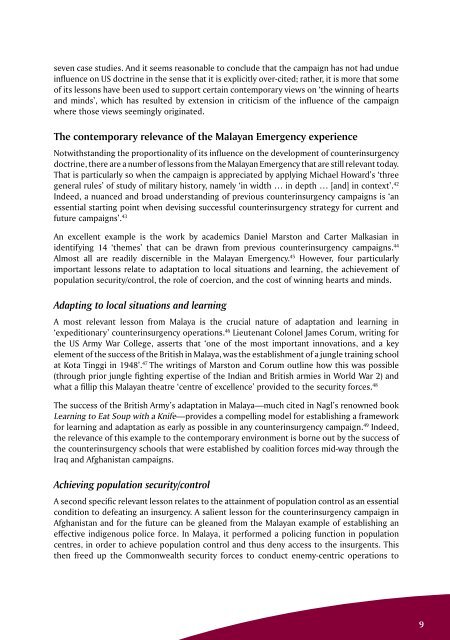ISSUE 191 : Jul/Aug - 2013 - Australian Defence Force Journal
ISSUE 191 : Jul/Aug - 2013 - Australian Defence Force Journal
ISSUE 191 : Jul/Aug - 2013 - Australian Defence Force Journal
- No tags were found...
Create successful ePaper yourself
Turn your PDF publications into a flip-book with our unique Google optimized e-Paper software.
seven case studies. And it seems reasonable to conclude that the campaign has not had undue<br />
influence on US doctrine in the sense that it is explicitly over-cited; rather, it is more that some<br />
of its lessons have been used to support certain contemporary views on ‘the winning of hearts<br />
and minds’, which has resulted by extension in criticism of the influence of the campaign<br />
where those views seemingly originated.<br />
The contemporary relevance of the Malayan Emergency experience<br />
Notwithstanding the proportionality of its influence on the development of counterinsurgency<br />
doctrine, there are a number of lessons from the Malayan Emergency that are still relevant today.<br />
That is particularly so when the campaign is appreciated by applying Michael Howard’s ‘three<br />
general rules’ of study of military history, namely ‘in width … in depth … [and] in context’. 42<br />
Indeed, a nuanced and broad understanding of previous counterinsurgency campaigns is ‘an<br />
essential starting point when devising successful counterinsurgency strategy for current and<br />
future campaigns’. 43<br />
An excellent example is the work by academics Daniel Marston and Carter Malkasian in<br />
identifying 14 ‘themes’ that can be drawn from previous counterinsurgency campaigns. 44<br />
Almost all are readily discernible in the Malayan Emergency. 45 However, four particularly<br />
important lessons relate to adaptation to local situations and learning, the achievement of<br />
population security/control, the role of coercion, and the cost of winning hearts and minds.<br />
Adapting to local situations and learning<br />
A most relevant lesson from Malaya is the crucial nature of adaptation and learning in<br />
‘expeditionary’ counterinsurgency operations. 46 Lieutenant Colonel James Corum, writing for<br />
the US Army War College, asserts that ‘one of the most important innovations, and a key<br />
element of the success of the British in Malaya, was the establishment of a jungle training school<br />
at Kota Tinggi in 1948’. 47 The writings of Marston and Corum outline how this was possible<br />
(through prior jungle fighting expertise of the Indian and British armies in World War 2) and<br />
what a fillip this Malayan theatre ‘centre of excellence’ provided to the security forces. 48<br />
The success of the British Army’s adaptation in Malaya—much cited in Nagl’s renowned book<br />
Learning to Eat Soup with a Knife—provides a compelling model for establishing a framework<br />
for learning and adaptation as early as possible in any counterinsurgency campaign. 49 Indeed,<br />
the relevance of this example to the contemporary environment is borne out by the success of<br />
the counterinsurgency schools that were established by coalition forces mid-way through the<br />
Iraq and Afghanistan campaigns.<br />
Achieving population security/control<br />
A second specific relevant lesson relates to the attainment of population control as an essential<br />
condition to defeating an insurgency. A salient lesson for the counterinsurgency campaign in<br />
Afghanistan and for the future can be gleaned from the Malayan example of establishing an<br />
effective indigenous police force. In Malaya, it performed a policing function in population<br />
centres, in order to achieve population control and thus deny access to the insurgents. This<br />
then freed up the Commonwealth security forces to conduct enemy-centric operations to<br />
9

















